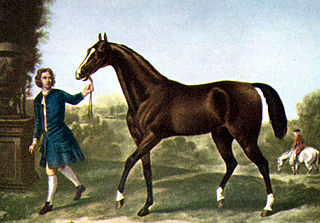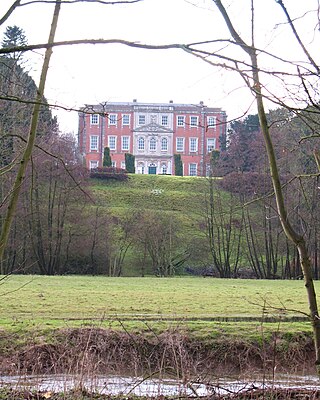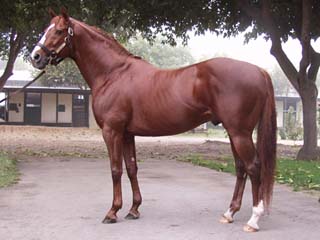
Ten Broeck is a home rule-class city in Jefferson County, Kentucky, United States. The population was 103 at the 2010 census.

The Darley Arabian was one of three dominant foundation sires of modern Thoroughbred horse racing bloodstock. The other two founders were the Godolphin Arabian and the Byerley Turk. This bay Arabian horse was bought in Aleppo, Syria, by Thomas Darley in 1704 and shipped to Aldby Park in England, as a present for his brother.

The Byerley Turk, also spelled Byerly Turk, was the earliest of three stallions that were the founders of the modern Thoroughbred horse racing bloodstock.

The Godolphin Arabian, also known as the Godolphin Barb, was an Arabian horse who was one of three stallions that founded the modern Thoroughbred. He was named after his best-known owner, Francis Godolphin, 2nd Earl of Godolphin.

Godolphin is the Maktoum family's private Thoroughbred horseracing stable and was named in honour of the Godolphin Arabian, who came from the desert to become one of the three founding stallions of the modern Thoroughbred. Godolphin is buried at Wandlebury Park in Cambridge, where there is a stone to commemorate this horse in the passageway of the old buildings.

Lexington was a United States Thoroughbred race horse who won six of his seven race starts. Perhaps his greatest fame, however, came as the most successful sire of the second half of the nineteenth century; he was the leading sire in North America 16 times, and broodmare sire of many notable racehorses.

The Black Stallion, known as the Black or Shêtân, is the title character from author Walter Farley's bestselling series about the Arab stallion and his young owner, Alec Ramsay. The series chronicles the story of a Sheikh's prized stallion after he comes into Alec's possession through a ship journey gone awry. Later books in the series furnish the Black's backstory. Shaytan is the Arabic word for "devil".
Darley or Darly may refer to:

Aldby Park is a country estate in the village of Buttercrambe near the village of Stamford Bridge in the East Riding of Yorkshire, England.

Diomed (1777–1808) was an English Thoroughbred race horse who won the inaugural running of the Epsom Derby in 1780. Sold and imported to Virginia, he was subsequently a successful sire in the United States after the American Revolutionary War.

Flying Childers (1715–1741) was a famous undefeated 18th-century thoroughbred racehorse, foaled in 1714 at Carr House, Warmsworth, Doncaster, and is sometimes considered as the first truly great racehorse in the history of thoroughbreds and the first to catch the public imagination.

The Norfolk Trotter is a historical horse breed once native to East Anglia and Norfolk, England. It was said to be "a large-sized trotting harness horse originating in and around Norfolk".
Dante (1942–1956) was a British Thoroughbred racehorse who was the last horse trained in northern England to win the English Derby. In a racing career which lasted from the spring of 1944 until June 1945 he ran nine times and won eight races. He was the top-rated British two-year-old of 1944 when he was unbeaten in six races including the Coventry Stakes and the Middle Park Stakes. In 1945 he was beaten when favourite for the 2000 Guineas but won the Derby, despite being afflicted by an eye condition which eventually left him completely blind. He was retired to a successful stud career before dying in 1956.

The Thoroughbred is a horse breed developed for horse racing. Although the word thoroughbred is sometimes used to refer to any breed of purebred horse, it technically refers only to the Thoroughbred breed. Thoroughbreds are considered "hot-blooded" horses that are known for their agility, speed, and spirit.

Waxy was a British Thoroughbred racehorse that won the 1793 Epsom Derby and was an influential sire in the late eighteenth and early part of the nineteenth century. Waxy was bred by Sir Ferdinando Poole and was foaled at Lewes in 1790. He was sired by Pot-8-Os, a son of the foundation stallion Eclipse, whose genetic lineage traced to the Darley Arabian. Waxy's dam, Maria, was sired by the influential stallion Herod and produced one full-brother to Waxy, who was named Worthy. Waxy derived his name from a variety of potato, a choice that was inspired by his sire's name. Trained by Robert Robson, Waxy won nine races out of 15 starts during his four-year racing career, retiring from racing at the age of seven in 1797 after sustaining an injury during his last start.
Meq'ed Ibn H'ddri, also Meq'ed of Hothail Albogoom was the sheikh of Hothail Albogom from the Adnanite tribe of Hothail. In the mid-19th century, he lived at Abar Alzayddi to the east of Alnir mountain in Najd. He was considered one of the most prominent knights of the Arabian Peninsula and a well-known owner of Arabian horse studs, including Ma'anagi H'ddri(or Hidrigi), Saklawi H'ddri and Kuhaila H'ddri.
Rafalca is a former dressage horse, co-owned by Ann Romney, that performed in the equestrian competition at the 2012 Summer Olympics, with rider Jan Ebeling. She was retired from competitions in 2014, and is now a broodmare.
Bartlett's Childers was an important Thoroughbred sire in the 18th century.
Park Appeal was an Irish Thoroughbred racehorse and broodmare. She was one of the leading two-year-old fillies of 1984 when she was undefeated in four races including the Moyglare Stud Stakes in Ireland and the Cheveley Park Stakes in Britain. Her later career was disappointing and she was retired with a record of five wins in eight races between August 1984 and August 1986. Having been bought by Sheikh Mohammed at the end of her two-year-old season, she later became a highly successful broodmare for the Darley Stud.

Black Allan or Allan F-1 was the foundation sire of the Tennessee Walking Horse. He was out of a Morgan and Thoroughbred cross mare named Maggie Marshall, a descendant of Figure and the Thoroughbred racing stallion Messenger; and sired by Allandorf, a Standardbred stallion descended from Hambletonian 10, also of the Messenger line.














